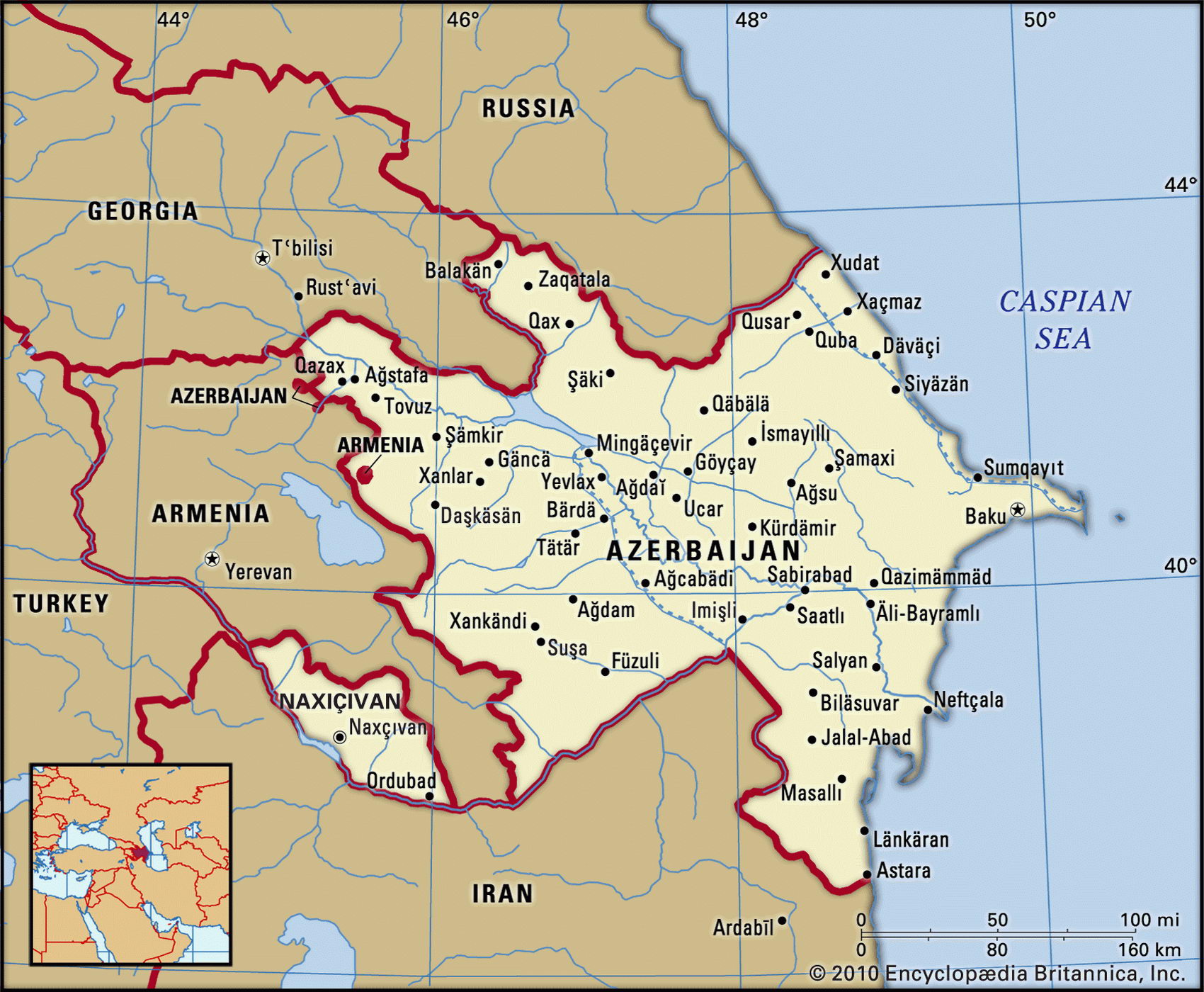Map of Azerbaijan and geographical facts
Azerbaijan on the world map. Map of Azerbaijan
Map of Azerbaijan with cities. Where Azerbaijan is on the world map. The main geographical facts about Azerbaijan - population, country area, capital, official language, religions, industry and culture.

Fact File Azerbaijan
Official name Azerbaijani Republic
Form of government Federal republic with single legislative body (National Assembly)
Capital Baki (Baku)
Area 86,600 sq km (33,436 sq miles)
Time zone GMT + 4 hours
Population 7,799,000
Projected population 2015 8,725,000
Population density 90.1 per sq km (233.3 per sq mile)
Life expectancy 63.1
Infant mortality (per 1,000) 82.7
Official language Azerbaijani
Other languages Russian, Armenian
Literacy rate 97%
Religions Muslim 93.4%, Russian Orthodox 2.3%, Armenian Orthodox 2.3%, other 2%
Ethnic groups Azeri 90%, Dagestani peoples 3.2%, Russian 2.5%, Armenian 2.3%, other 2%
Currency Manat
Central and West Asia
Economy Services 42%, agriculture 32%, industry 26%
GNP per capita US$ 3,300
Climate Mainly semiarid
Highest point Bazarduzu Dag 4,466 m (14,652 ft) Map reference Page 222
Oil was being collected from the Caspian Sea near Baku at least 1,000 years ago, when the area was known as "land of eternal fire" because of burning natural gas flaming out of the ground. Today oil from Baku continues to be the mainstay of the Azerbaijani economy. The home of an independent Azeri state as early as the fourth century bc, the region later fell under the influence of Persia, then in the eleventh century Turkic-speaking people moved in and assumed control. A period of affiliation with the Soviets following the Russian Revolution led to Azerbaijan becoming a member of the Soviet Union in 1936. In 1990 it was one of the first Soviet Republics to declare independence.
Since 1988 there have been troubles with Armenia over the region of Nagorno-Karabakh in southwestern Azerbaijan. This territorial dispute (Armenia now holds twenty percent of the region, most of the people in Nagorno-Karabakh being Christian Armenians) remains a major political problem for the newly independent state.
A range of the Great Caucasus (Bol'shoy Kavkas) running at an angle toward the Caspian Sea separates Russia from Azerbaijan, and reaches almost as far as Baku. South of this range, draining out of the foothills of the Caucasus in Georgia, the Kura (Kiir) River reaches a broad floodplain, some of which lies below sea level. The mountains of the Lesser Caucasus (Malyy Kavkaz) form much of Nagorno-Karabakh in the southwest and also stand between Azerbaijan and its isolated enclave-territory Naxcivan. Although a Naxcivan independence movement exists, this territory, which is surrounded by Iran and Armenia, is regarded by the government as part of the Azerbaijan state. Dry and subtropical, the lowlands experience mild winters and long, hot summers, and are frequently affected by drought. Plant cover consists of steppe grassland in the drier lowland regions, woods in the mountains, and swamps in the southeast.
Early this century Baku supplied as much as half the world's oil, but production declined steadily during the final years under Soviet control as plants became antiquated and maintenance was neglected. The 1994 ratification of a $7.5 billion deal with a consortium of Western oil companies marked a turning point, and a revival in this sector can be expected. Baku was the fifth biggest city in Soviet Russia and had a well diversified industrial sector. It is hoped the oil deal will stimulate new production of chemicals, textiles, and electrical goods.
Though Azerbaijan has only a small amount of arable land, it is a major producer of cotton, tobacco, grapes, and other fruit. Sturgeon from the Caspian was an important source of caviar but this industry is threatened by serious water pollution. One hundred years of intensive oil production, plus overuse of toxic defoliants in cotton growing, have taken a severe environmental toll. Azerbaijani scientists consider the Abseron Peninsula, where Baku stands, to be one of the most ecologically devastated areas in the world.